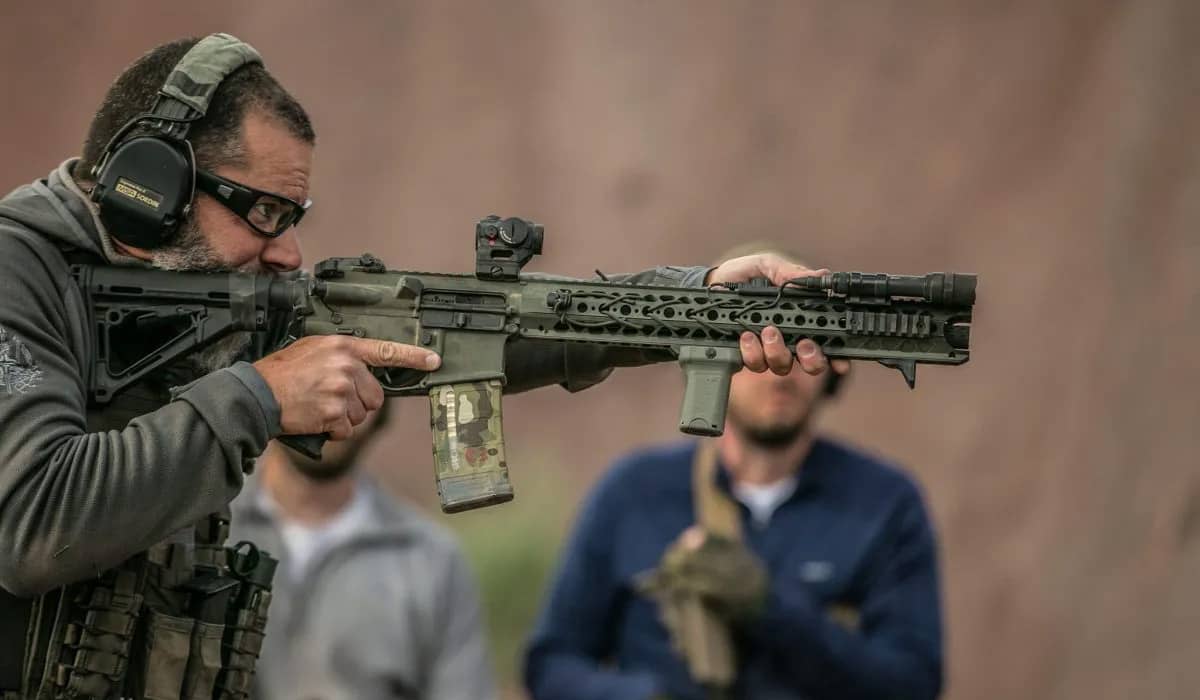Updated June 23, 2021

If you have read anything in the media about what an AR-15 actually is, you know that the plethora of info can be confusing. The media definition of an AR-15 and what the “AR” in “AR-15” actually stands for can also change, depending on what you’re reading. In this article, we are going to explain what the AR-15 is, the history of the AR-15, how it operates on a basic level, and what the “AR” in “AR-15” actually stands for.
Brief History Of The AR-15
The AR-15, as it's known throughout the United States and many other countries, is the single most popular rifle sold in the United States today. It was originally designed in the 1950s by a team of engineers at ArmaLite. The design team behind that famous rifle was Eugene Stoner, Bob Fremont, and Jim Sullivan. Although the AR-15 was intended for military service, it did not see a whole lot of success in the late 50’s when the rifle first hit the market. Three years later, ArmaLite made the decision to sell the rights and the logo to the AR-10 and the AR-15 both. Unfortunately, ArmaLite did not have enough manpower, monetary resources, and lacked the facilities for high-level production. Certain changes were made to the original ArmaLite AR-15 before Colt began manufacturing the design for the military. Colt would go on to sell and manufacture a modified, select-fire version of the AR-15 Rifle known as the Colt M-16 for the U.S. Military. Colt Manufacturing would retain this contract for multiple years providing the military with the M-16, M-16A1, M4, and numerous other different and upgraded versions of the same rifle system.
What Is AR-15
Now that we know more about the history of it, let’s find out more about what is AR-15 and how it operates.
Does AR stand for Assault Rifle?
It is widely reported throughout the media and popular culture that the “AR” in AR-15 stands for “assault rifle”. This is incorrect. So, what does “AR” stand for in AR-15? It stands for "ArmaLite Rifle", named after the company the rifle was originally designed by.
THE BENEFITS OF OWNING AN AR-15
The AR-15 platform is one of the most versatile out there. It is a top choice for gun owners of every experience level, with several key advantages that make it unique:
- Accuracy: Even with iron sights, you can use an AR-15 rifle to hit targets with accuracy at several hundred yards. Add some optics and you can reach out even further while still keeping your rounds in tight groups.
- Reliability: The AR-15 is one of the most reliable rifles on the market, and you can add to that by upgrading your components with aftermarket parts like new barrels, enhanced bolt carrier groups and better magazines.
- Adaptability: Millions of Americans own AR-15s, and a big part of that success is how adaptable they are. These rifles are legendary for military and police use but also have numerous applications for civilian shooters.
- Customization: AR-15s are modular by design. You can take them apart and swap virtually every part out for something better suited to your needs and personal preferences, including aesthetic modifications and components designed to change their function. You can even change the caliber of your firearm by popping out two pins and swapping in a new upper assembly.
AR-15 APPLICATIONS
The "AR" in AR-15 is often mistaken for meaning "assault rifle." This mistake gives the impression these guns are made strictly for combat engagements, but that couldn't be further from the truth. What "AR" does stand for is ArmaLite Rifle — the original manufacturer of this rifle design. Today, these rifles are produced by countless manufacturers and have multiple applications for civilian use.
1. Hunting
Thanks to their modular design, you can configure your AR-15 to take on game ranging from varmints to big game. Most rifles come chambered in .223 — an ideal caliber for animals like coyotes, foxes and rabbits. You can also configure them to fire rounds like the .300 Blackout, 6.5 Grendel and the .450 Bushmaster depending on what you're looking to bag.
2. Self-Defense

You can use an AR-15 to defend your home. AR-15s can take on collapsible buttstocks and shorter barrels than most rifles, making it easier to use them in tight spaces and move around corners. They also have little recoil, and you can equip them with advanced sights that make it easier to acquire your target, even in low-light conditions.
3. Competition

In most cases, AR-15s are accurate for hitting targets at anywhere from 400 to 600 yards. You can even use them for longer distances with the right parts. This incredible precision, plus a high magazine capacity, lightweight design and modular capability, makes the AR-15 a popular choice in a wide range of different shooting competitions, like 3-gun competitions.
WHO CAN PURCHASE AN AR-15?
AR-15 ownership laws vary by state, as they qualify as magazine-fed semi-automatic rifles. AR-15s also have pistol grips and the option for collapsible buttstocks. These features are enough for AR-15s to be classified "assault rifles" by some definitions, making them illegal to own in states, counties and cities with assault rifle bans.
The majority of states permit AR-15 ownership. Places where they're outlawed entirely include:
- New York
- Maryland
- California
- New Jersey
- Connecticut
- Massachusetts
Other states have laws regarding what caliber you can use, with several mandating that hunters must use rounds larger than .223. Be sure to do thorough research for your specific area before heading out in search of game.
Why People Call AR-15 “Black Rifle”?
The AR-15 is known as the “Black Rifle” for a good reason, because it usually comes from the factory with black furniture, an upper and lower receiver that is anodized black, and the rest of the metal parts are usually ‘parkerized’ in a dark grey finish. Together, these parts and pieces give the AR-15 the look of a “Black Rifle”. The semi-automatic civilian AR-15 and its military counterpart, the M-16, are both widely considered to be one of the safest rifles to handle on the market. Not just for hunting and competition shooting, but for other purposes as well. The military emphasizes safety over all else, so when the AR-15 was designed, it was built with robust safety features. The AR-15 consists of the upper and lower receiver, barrel and muzzle device, sights, gas block, and gas tube, furniture, fire control group, charging handle, bolt carrier group, magazine, receiver extension, buffer, and buffer spring. The multi-round box magazine feeds cartridges during its cycle of operation.

Steps In The Functioning Of The AR-15
There are 8 steps in the AR-15 cycle of operation. The steps start after pulling the charging handle. Pulling back on the charging handle causes the bolt carrier group to compress the buffer spring.
- Feeding: After releasing the charging handle, the first step is “feeding”, which involves the forward movement of the bolt carrier group and the bolt stripping a cartridge from the magazine as it travels forward.
- Chambering: The step following that is “chambering”, in which the cartridge that was stripped from the magazine is loaded or “chambered” into the barrel.
- Locking: The next step is the “locking” or “lock up”. The “locking” happens when the bolt has pushed the cartridge all the way into the chamber and then the camming action inside the bolt carrier group turns the bolt counter-clockwise, locking the bolt into the lugs of the barrel extension.
- Firing: Up next is the “firing” part of the cycle. When you press the trigger, the hammer of the fire control group is released and strikes the firing pin, which impacts the primer of the cartridge, igniting the powder, and sending the bullet down the barrel.
- Unlocking: The step following ‘firing’ is called “Unlocking”. The “Unlocking” portion of the cycle happens when the gas from the fired cartridge travels through the barrel, up into the gas block, through the gas tube into the gas key, and unlocking the bolt by pushing the bolt carrier group rearwards.
- Extracting: The “extracting” part of the cycle is next. The extraction happens as the bolt and bolt carrier travels backward. The extractor claw on the bolt grabs onto the rim of the cartridge from the time the “feeding” portion of the cycle starts, and as the bolt and carrier travels to the rear, it pulls the shell or case from the chamber.
- Ejecting: As the bolt carrier group pulls the shell from the chamber, the bolt and carrier continue to move to the rear, and “ejecting” happens as soon as the shell moves into the ejection port area. Once the shell casing is in the ejection port opening, the ejector is engaged, causing the shell to fly out of the receiver.
- Cocking: Then the bolt carrier group continues to move rearward, “cocking” the hammer on its way back and keeps going until it compresses the buffer spring fully and the cycle starts all over again.
What Makes The AR-15 The Most Popular Rifle in the United States
One of the best things about the AR-15 system is how modular it is. The AR-15 is sold as a complete rifle, as a complete upper receiver that you can attach to your existing lower receiver, or as a complete lower so you can attach your existing upper to it, and each part is also sold individually by multiple manufacturers so you can build one yourself, from the beginning. It requires few tools to build, it’s simple to customize, and easy to maintain. One other unique factor about the AR-15 platform is the enormous variety of aftermarket parts and vast industry support available for it. There is no other firearm out there that provides the level of custom, aftermarket, and factory parts that the AR-15 currently does. In conclusion, if you want to purchase a safe, time-tested, reliable firearm for yourself or someone else that can be completely customized to fit almost any role, look no further than the AR-15.